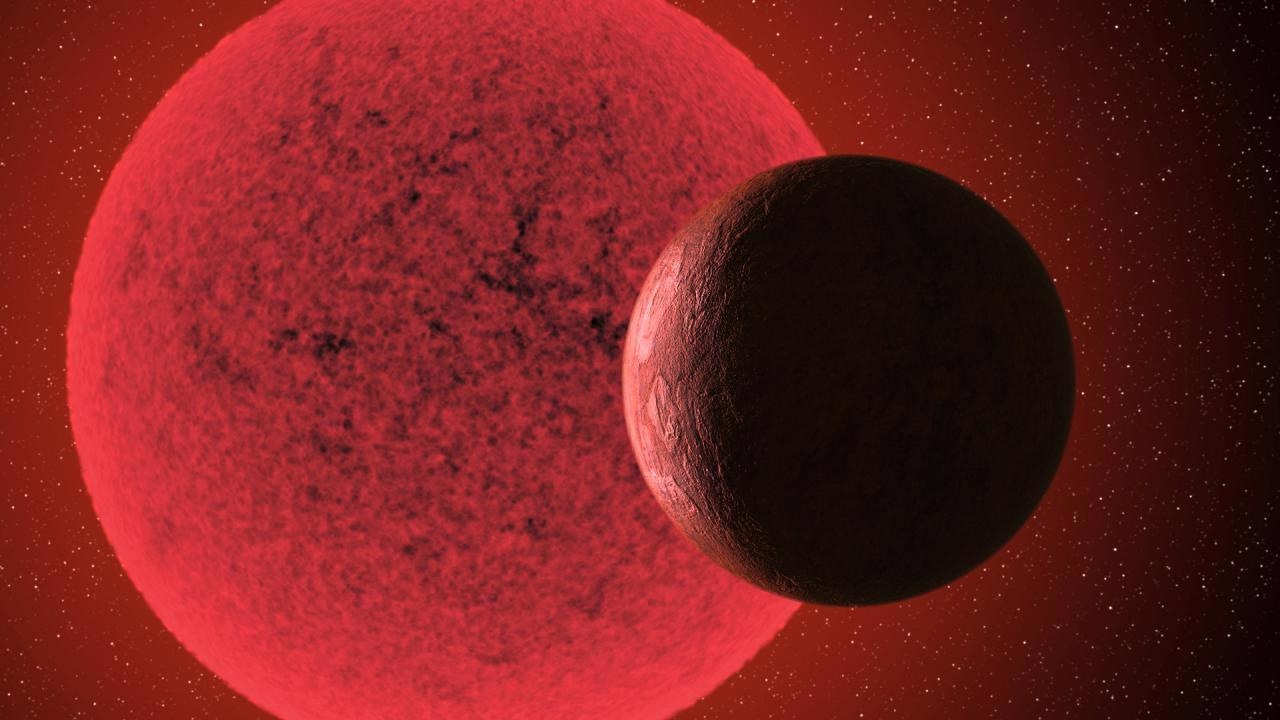Apr 19 2021
In the recent past, red dwarf stars have been thoroughly studied to detect exoplanets orbiting around them. Such stars have effective surface temperatures ranging from 2400 to 3700 K (more than 2000 degrees cooler when compared to that of the Sun) and solar masses from 0.08 to 0.45.
 Artistic impression of the super-Earth in orbit around the red dwarf star GJ-740. Image Credit: Gabriel Pérez Díaz, SMM, Instituto de Astrofísica de Canarias (IAC).
Artistic impression of the super-Earth in orbit around the red dwarf star GJ-740. Image Credit: Gabriel Pérez Díaz, SMM, Instituto de Astrofísica de Canarias (IAC).
A research team headed by Borja Toledo Padrón, a Severo Ochoa-La Caixa doctoral student from the Instituto de Astrofísica de Canarias (IAC) who specializes in looking for planets around this kind of stars, has identified a super-Earth exoplanet orbiting the GJ 740 star—a red dwarf star located about 36 light-years from the planet Earth.
This exoplanet revolves around its star with a duration of 2.4 days and its mass is about three times that of Earth’s mass. Since the star is very close to the Sun, and the planet, in turn, is quite close to the star, the newly discovered exoplanet could be the object of upcoming studies using very large diameter telescopes toward the conclusion of this decade.
The study results were recently published in the Astronomy & Astrophysics journal.
This is the planet with the second shortest orbital period around this type of star. The mass and the period suggest a rocky planet, with a radius of around 1.4 Earth radii, which could be confirmed in future observations with the TESS satellite.
Borja Toledo Padrón, Study First Author, Instituto de Astrofísica de Canarias
This data also suggests the existence of a second planet with an orbital duration of nine years, and a mass similar to that of Saturn (almost 100 masses of the Earth), albeit its radial velocity signal could have been caused by the star magnetic cycle (analogous to that of the Sun), so that additional information is required to validate that the signal is actually caused by a planet.
The Kepler mission is known as one of the most effective programs in identifying exoplanets through the transit technique (which is the quest for slight changes in the brightness of a star induced by the transit between it and the planets revolving around it). It has identified a total of 156 exotic planets around cool stars.
Based on this data, it has been predicted that this kind of star has an average of 2.5 planets with less than 200 days of orbital periods.
The search for new exoplanets around cool stars is driven by the smaller difference between the planet’s mass and the star’s mass compared with stars in warmer spectral classes (which facilitates the detection of the planets’ signals), as well as the large number of this type of stars in our Galaxy.
Borja Toledo Padrón, Study First Author, Instituto de Astrofísica de Canarias
Cool stars are a perfect target for searching planets through the radial velocity technique. This technique is based on the detection of sight changes in the star velocity caused by the gravitational attraction of a planet orbiting around it, through spectroscopic observations.
The first radial velocity signal of an exoplanet around a cool star was discovered in 1998 and since that discovery, a total of 116 exoplanets have been detected so far around this group of stars with the radial velocity technique.
The main difficulty of this method is related to the intense magnetic activity of this type of stars, which can produce spectroscopic signals very similar to those due to an exoplanet.
Jonay I. González Hernández, Study Co-Author and Researcher, Instituto de Astrofísica de Canarias
The research work is part of the project HArps-n red Dwarf Exoplanet Survey (HADES) where the IAC is teaming up with the Institut de Ciències de l’Espai (IEEC-CSIC) of Catalonia, and the Italian program Global Architecture of Planetary Systems (GAPS), whose goal is to identify and characterize exoplanets around cool stars for which HARPS-N is being used on the Telescopio Nazionale Galileo (TNG) at the Roque de los Muchachos Observatory (Garafía, La Palma).
This discovery was possible, thanks to a six-year observing program with HARPS-N, supplemented with measurements with the CARMENES spectrograph on the 3.5-m telescope deployed at the Calar Alto Observatory (Almería) and HARPS on the 3.6-m telescope at the La Silla Observatory (Chile), and also due to a photometric support from the EXORAP and ASAP surveys.
IAC scientists Alejandro Suárez Mascareño and Rafael Rebolo also participated in the study.
Journal Reference:
Toledo-Padrón, B., et al. (2021) A super-Earth on a close-in orbit around the M1V star GJ 740. Astronomy & Astrophysics. doi.org/10.1051/0004-6361/202040099.